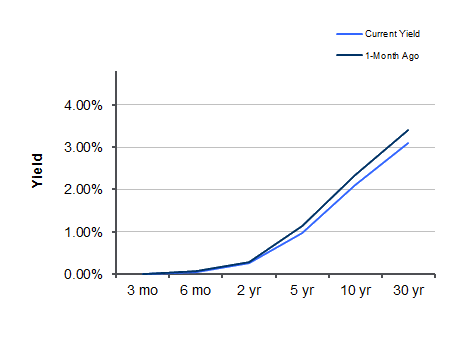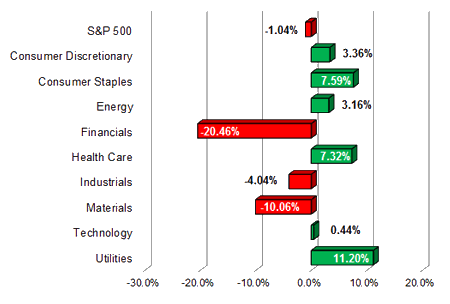
Market Commentary by Scott J. Brown, Ph.D., Chief Economist

Following a horrible Thanksgiving Day holiday week, the stock market was due for a bounce, but the rebound was aided significantly by central bank action and favorable economic data.
The Federal Reserve joined five other central banks in efforts to boost dollar liquidity. The price of dollar swap arrangements between central banks was reduced to 50 basis points over the Overnight Index Swap rate (OIS), vs. 100 bps over OIS previously, and swap lines were extended to February 1st, 2013. This is U.S. dollar liquidity we’re talking about, but as a contingency measure, the central banks agreed to establish temporary liquidity facilities in other currency (euros, perhaps?) “should market conditions warrant.” The move does not go to the heart of Europe’s problems, but does aim to prevent the sort of seizing up that occurred among large global banks during the crisis of three year ago. Meanwhile, ECB president Draghi hinted of more support from the ECB if leaders could agree to a more comprehensive fiscal compact (a restatement of fiscal rules and enforcement of mutual commitments).
The unemployment rate fell to 8.6% in November, vs. 9.0% in October and 9.8% a year ago. However, most of that decline was due to a decrease in the labor force. The employment-population ratio edged up to 58.5%, vs. 58.4% in October and 58.2% last year. Nonfarm payrolls rose by 120,000 (matching expectations) with a net +72,000 revision to September and October. Average hourly earnings fell 0.1% (which could be related to a shift in the mix – that is more, retail jobs, which pay a lot less), up 1.7% year-over-year (in comparison, the CPI rose 3.6% over the 12 months ending in October).
Next week, the economic calendar thins out (the following week will make up for that). The focus is likely to remain on Europe, where leaders are working hard to come up with a fiscal compact, which, if credible, could lead to more support from the European Central Bank. However, we’ve seen this movie before and it usually doesn’t end well. Congress may move toward an extension of the payroll tax reduction.
Indices
| Last | Last Week | YTD return % | |
| DJIA | 12020.03 | 11257.55 | 3.82% |
| NASDAQ | 2626.20 | 2460.08 | -1.01% |
| S&P 500 | 1244.58 | 1161.79 | -1.04% |
| MSCI EAFE | 1431.70 | 1329.58 | -13.66% |
| Russell 2000 | 730.75 | 674.34 | -6.75% |
Consumer Money Rates
| Last | 1-year ago | |
| Prime Rate | 3.25 | 3.25 |
| Fed Funds | 0.07 | 0.18 |
| 30-year mortgage | 4.02 | 4.66 |
Currencies
| Last | 1-year ago | |
| Dollars per British Pound | 1.569 | 1.559 |
| Dollars per Euro | 1.344 | 1.313 |
| Japanese Yen per Dollar | 77.700 | 84.220 |
| Canadian Dollars per Dollar | 1.016 | 1.016 |
| Mexican Peso per Dollar | 13.653 | 12.373 |
Commodities
| Last | 1-year ago | |
| Crude Oil | 100.20 | 86.75 |
| Gold | 1736.03 | 1390.83 |
Bond Rates
| Last | 1-month ago | |
| 2-year treasury | 0.27 | 0.29 |
| 10-year treasury | 2.11 | 2.34 |
| 10-year municipal (TEY) | 3.36 | 3.70 |
Treasury Yield Curve – 12/2/2011

S&P Sector Performance (YTD) – 12/2/2011

Economic Calendar
| December 2nd |
— |
Employment Report (November) |
| December 5th |
— |
ISM Non-Manufacturing Index (November) |
| December 13th |
— |
Retail Sales (November) FOMC Policy Decision (no press briefing) |
| December 16th |
— |
Consumer Price Index (November) |
| December 26th |
— |
Christmas Holiday (markets closed) |
Important Disclosures
Past performance is not a guarantee of future results. There are special risks involved with global investing related to market and currency fluctuations, economic and political instability, and different financial accounting standards. The above material has been obtained from sources considered reliable, but we do not guarantee that it is accurate or complete. There is no assurance that any trends mentioned will continue in the future. While interest on municipal bonds is generally exempt from federal income tax, it may be subject to the federal alternative minimum tax, state or local taxes. In addition, certain municipal bonds (such as Build America Bonds) are issued without a federal tax exemption, which subjects the related interest income to federal income tax. Investing involves risk and investors may incur a profit or a loss.
US government bonds and treasury bills are guaranteed by the US government and, if held to maturity, offer a fixed rate of return and guaranteed principal value. US government bonds are issued and guaranteed as to the timely payment of principal and interest by the federal government. Treasury bills are certificates reflecting short-term (less than one year) obligations of the US government.
Commodities trading is generally considered speculative because of the significant potential for investment loss. Markets for commodities are likely to be volatile and there may be sharp price fluctuations even during periods when prices overall are rising. Specific sector investing can be subject to different and greater risks than more diversified investments.
Tax Equiv Muni yields (TEY) assume a 35% tax rate on triple-A rated, tax-exempt insured revenue bonds.
![]() Material prepared by Raymond James for use by its financial advisors.
Material prepared by Raymond James for use by its financial advisors.
The information contained herein has been obtained from sources considered reliable, but we do not guarantee that the foregoing material is accurate or complete. Data source: Bloomberg, as of close of business December 1st, 2011.
©2011 Raymond James Financial Services, Inc. member FINRA / SIPC.


